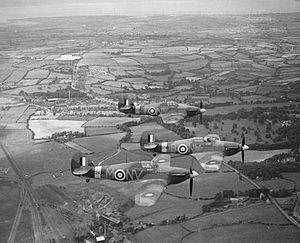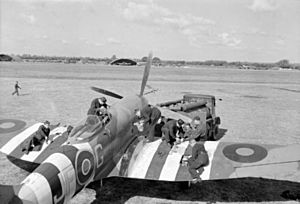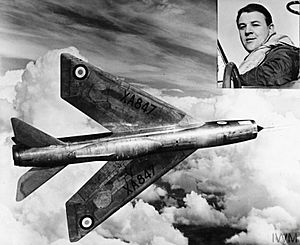Roland Beamont facts for kids
Quick facts for kids
Roland Prosper Beamont
|
|
|---|---|
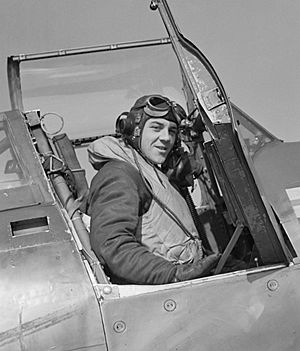
Squadron Leader R P Beamont of No. 609 Squadron RAF, in his Hawker Typhoon Mark IB
|
|
| Nickname(s) | Bee |
| Born | 10 August 1920 Enfield, Middlesex |
| Died | 19 November 2001 (aged 81) Hampshire |
| Allegiance | United Kingdom |
| Service/ |
Royal Air Force |
| Years of service | 1939–1979 |
| Rank | Wing commander |
| Unit | No. 87 Squadron RAF No. 79 Squadron RAF No. 150 Wing RAF |
| Commands held | No. 609 Squadron RAF (1942–43) |
| Battles/wars | Second World War |
| Awards | Commander of the Order of the British Empire Distinguished Service Order & Bar Distinguished Flying Cross & Bar Distinguished Flying Cross (United States) Croix de guerre (Belgium) |
| Other work | Test pilot Author |
Wing Commander Roland Prosper "Bee" Beamont (10 August 1920 – 19 November 2001) was a brave British fighter pilot for the Royal Air Force (RAF). He was also an amazing experimental test pilot during and after the Second World War. He was the first British pilot to fly faster than the speed of sound (called Mach 1) in a British plane during level flight. He was also the first to fly a British plane at Mach 2 (twice the speed of sound)!
During the Second World War, Roland flew over 500 missions. He also spent months helping to develop new planes like the Hawker Typhoon and Tempest. He was key in getting these planes ready for combat. He helped create new ways for the Typhoon to attack targets on the ground. He also led the fight against the V-1 flying bombs, which were dangerous unmanned bombs.
After the war, he became a chief test pilot for companies like English Electric and British Aircraft Corporation (BAC). He was the first to fly many important planes, including the Canberra, the Lightning, and the TSR-2.
When he stopped test flying in 1968, he had flown 167 different types of aircraft! He spent 5,100 hours in the air across 8,000 flights. More than 1,100 of these flights were supersonic (faster than sound). He even set three records for flying across the Atlantic Ocean in the Canberra. One record was for flying across the Atlantic and back within 24 hours. Later, he helped test the Tornado jet. After retiring, he wrote many books about his exciting experiences.
Beamont was a very careful pilot. He was proud that he never crashed a plane or had to bail out. Even when his Tempest was shot down, he managed to land it safely and walked away without injury.
Contents
Early Life and Joining the RAF
Roland Prosper Beamont was born on 10 August 1920 in Enfield, England. His father worked for the government, and his mother was Dorothy Mary. Roland grew up in Chichester and loved aviation from a young age. His very first flight was in 1926 when he was just six years old! A pilot landed an Avro 504 plane near his home and took Roland and his father for a ride. After that, Roland saved all his pocket money to buy flying books and model airplanes.
He spent his school holidays cycling to Tangmere airfield to watch the RAF's Hawker Furies fly. His parents supported his interest and sent him to Eastbourne College. They hoped he would join the RAF College Cranwell. He even got to take the controls of an Avro Tutor plane when he was 16.
Roland wasn't the best student, but he worked hard and managed to pass his exams. On 2 September 1939, he began his flight training. He learned to fly civilian planes first. He then moved on to Hawker Harts and Hurricanes. He became a pilot officer in October 1939. Soon after, he was sent to France to join No. 87 Squadron.
RAF Career
Flying the Hurricane
When Beamont arrived in France, he had only 15 hours of experience flying Hurricanes. In the spring of 1940, he saw more action. He helped shoot down a Heinkel He 111 bomber in March. On 8 May, he shot down a Dornier Do 17.
When his squadron returned to England, they helped defend South Western England during the Battle of Britain. Beamont shot down several enemy planes during this time. These included a Junkers Ju 88 and two Messerschmitt Bf 110s. He also got a Dornier Do 17 and a Messerschmitt Bf 109.
Beamont later said that flying during the Battle of Britain felt very personal. He knew his family was nearby, and he felt strongly that he and his fellow pilots had to fight their hardest to protect their country and homes.
During the Blitz air raids, his squadron flew night missions to defend Bristol. It was hard to see enemy planes at night. Beamont suggested they fly across the English Channel on moonlit nights to attack German airfields. This idea worked well, and Beamont helped destroy several enemy aircraft.
In May 1941, he moved to No. 79 Squadron RAF. In June, he received the Distinguished Flying Cross for his bravery. He worked to improve his new flight's spirits by practicing night flying and formation aerobatics. He once broke a rule by giving a ride to a female officer in his single-seat Hurricane. This led to a formal warning, but it also led to his marriage later on!
After his combat duties ended, he chose to become a test pilot at Hawker's. He learned a lot about how planes fly and how to test them safely. He helped test early versions of the Typhoon plane.
Flying the Typhoon
Beamont really wanted to fly the Typhoon in combat. He joined No. 609 Squadron RAF in October 1942. By January 1943, he was promoted to squadron leader.
At first, the Typhoon had problems. Many planes were lost due to engine or structural failures, not enemy action. As a squadron leader, Beamont strongly argued that the Typhoon should stay in service. He met with senior RAF leaders and convinced them that the plane's basic design was good. He said it was easy to fly, stable for shooting, and faster and more agile than German fighters. Thanks to Beamont, the Typhoon was saved.
From March 1942, German fighter-bombers attacked the south coast of England. Beamont's squadron moved to RAF Manston. They flew patrols from dawn to dusk to stop the German Focke-Wulf Fw 190 fighter-bombers. Beamont also developed ways to use the Typhoon as a night attacker. He flew solo missions at night, attacking trains to show that the Typhoon could be used safely and effectively in the dark.
Beamont was awarded a bar to his Distinguished Service Order in June 1943. This was for destroying 13 trains and many lorries.
Flying the Tempest
In May 1943, Beamont returned to Hawker's to test the new Tempest plane. In February 1944, he was asked to form the first Tempest wing (No. 150). He became an acting wing commander. By May 1944, his wing was ready for action. They flew ground attack missions against trains and airfields. On 8 June, his wing shot down three German planes over the D-Day invasion beaches. Beamont got the first one, which was also the first kill for a Tempest.
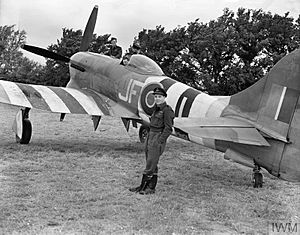
From his airfield, Beamont saw the first V-1 flying bombs flying towards London on 14 June. Two days later, his wing was assigned to stop them. He and his pilots tried different ways to attack the V-1s. Beamont found that attacking too close was dangerous because the V-1 could explode. He learned that the best way was to approach from behind at an angle. He even once defeated a V-1 by carefully sliding his wing-tip under it and flipping it over! His fifth V-1 kill on 19 June made him the first "V-1 ace." By the end of the V-1 campaign, his wing had shot down 638 of them, and Beamont personally accounted for 32.
On 2 October 1944, he shot down his ninth and final enemy plane of the war, a Fw 190. On 12 October, during his 492nd mission, his Tempest was hit by anti-aircraft fire while attacking a train. He crash-landed safely but became a prisoner of war (PoW). He was held in prison camps until the war ended in May 1945.
After the war, Beamont helped prepare for the planned invasion of Japan by forming the first wing of Hawker Tempest IIs. These planes were meant to escort bombers over Japan. However, the operation was canceled after the atomic bombs were dropped. In May 1946, he received the American Distinguished Flying Cross.
Test Pilot Career
After the war, Beamont decided to become a full-time test pilot. He worked for Gloster, testing the Meteor F4 jet. He even flew it at 632 miles per hour in preparation for an official speed record.
Testing the Canberra
In 1947, Beamont became the chief test pilot for English Electric. At the time, they were designing Britain's first jet bomber. On 13 May 1949, he made the first flight of the Canberra prototype. The Canberra was very powerful and easy to fly. Beamont showed off its amazing abilities at the Farnborough air show. People were very impressed.
Beamont set two transatlantic records in the Canberra. On 31 August 1951, he flew from Northern Ireland to Newfoundland, Canada, in just 4 hours, 18 minutes. The next year, on 26 August 1952, he became the first pilot to fly a jet across the Atlantic and back again in one day! This amazing flight took 10 hours and 3 minutes.
Testing the Lightning
The English Electric P.1 was designed to be the RAF's first jet that could fly at Mach 2 (twice the speed of sound). It had a very unique wing shape. On 4 August 1954, Beamont made the first flight of the P.1A. Just one week later, during its third flight, the plane reached Mach 1 in level flight for the first time!
On 4 April 1957, Beamont made the first flight of the P.1B, which was an improved version. During this flight, he again flew faster than Mach 1. Then, on 25 November, he reached Mach 2. This was the first time a British aircraft had flown that fast!
Testing the TSR-2
The TSR-2 was a new type of supersonic jet designed to fly very low to the ground. On 27 September 1964, Beamont made the first flight of the TSR-2. Even though there were some challenges with the plane's engines and landing gear, Beamont found it to be a very precise and easy-to-control aircraft.
He continued to test the TSR-2, even when problems arose. On one flight, he noticed a strong vibration that blurred his vision. He figured out the problem and landed the plane safely. On another flight, the landing gear got stuck in a strange position. Beamont, confident in the plane's control, managed to land it without any issues. On his tenth flight, he successfully retracted the landing gear and flew the TSR-2 at high speeds, even flying it low over the runway at 450 knots (about 518 miles per hour).
On Flight 14, Beamont flew the TSR-2 faster than Mach 1 for the first time, using only "dry power" (without afterburners). He then used one afterburner, and the aircraft quickly sped away from the chase plane.
Later Career and Retirement
In 1960, Beamont became a special director at English Electric Aviation. In May 1965, he stopped flying prototype planes but continued to test production Lightnings until 1968. By then, he had flown 167 different types of aircraft. He had spent 5,100 hours in the air and completed 8,000 flights, with over 1,100 of them being supersonic.
In 1971, he became the flight operations director for Panavia, where he was in charge of testing the Tornado jet. He retired in August 1979 after the first production Tornado took its maiden flight. After retiring, he spent his time writing for aviation magazines and publishing many books about his experiences. He passed away on 19 November 2001, at the age of 81.
In 2002, he was given the Belgian Croix de guerre award after his death.
Personal Life
Besides flying, Beamont enjoyed dinghy sailing and studying birds (being an ornithologist). On 13 October 1942, he married Shirley Dagmar Adams. They had a daughter named Carol, born in 1943. Sadly, Shirley passed away in May 1945. On 14 March 1947, he married Patricia Whitehead. With Patricia, he had two more daughters and helped raise her son from a previous marriage.
Books
- Phoenix into Ashes – Roland Beamont – William Kimber – 1968 – ISBN: 0-7183-0121-8
- Typhoon and Tempest at War – Arthur Reed & Roland Beamont – Ian Allan – 1977 – ISBN: 0-7110-0542-7
- Testing Years – Roland Beamont – Ian Allan – 1980 – ISBN: 0-7110-1072-2
- English Electric Canberra – Roland Beamont & Arthur Reed – Ian Allan – 1984 – ISBN: 0-7110-1343-8
- English Electric P1 Lightning – Roland Beamont – Ian Allan – 1985 – ISBN: 0-7110-1471-X
- Fighter Test Pilot: From Hurricane to Tornado – Roland Beamont – HarperCollins – 1986 – ISBN: 0-85059-850-8
- My Part of the Sky – Roland Beamont – Patrick Stephens – 1989 – ISBN: 1-85260-079-9
- Testing Early Jets – Roland Beamont – Airlife – 1990 – ISBN: 1-85310-158-3
- Tempest over Europe – Roland Beamont – Airlife – 1994 – ISBN: 1-85310-452-3
- Flying to the Limit: Reminiscences of Air Combat, Test Flying and the Aircraft Industry – Roland Beamont – Patrick Stephens – 1996 – ISBN: 1-85260-553-7
- The Years Flew Past: 40 Years at the Leading Edge of Aviation – Roland "Bee" Beamont – Crowood Press – 2001 – ISBN: 1-84037-299-0



